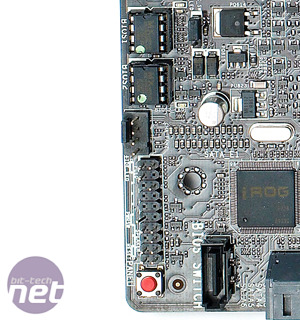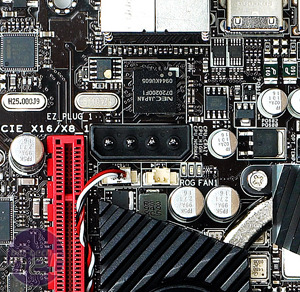Up Close: Asus Rampage III Extreme
There are also two Molex sockets on the board to provide extra power to the 16x PCI-E slots, which could possibly be useful if you’re trying to break the 3DMark record. The R3E also sports a new power circuit design that Asus claims runs cooler and responds more quickly to changes in power demand than the earlier R2E.Beyond these mundane features, the R3E
 sports a huge number of RoG-specific overclocking features. In addition to the typical power and reset switches, there are also several other buttons on the PCB itself. The Go button has two functions: during POST, it activates MemOK! to check memory compatibility, while in Windows, it loads an overclock profile that you created earlier.
sports a huge number of RoG-specific overclocking features. In addition to the typical power and reset switches, there are also several other buttons on the PCB itself. The Go button has two functions: during POST, it activates MemOK! to check memory compatibility, while in Windows, it loads an overclock profile that you created earlier.The BIOS button switches between the two BIOS chips on the board on the fly, which effectively doubles the eight profiles you can save in each BIOS. However, we’re not quite sure that you really need 16 different profiles at the same time.
Finally, the Q reset essentially acts as an all-in-one BIOS clear and reset button, which could be useful if your system won’t POST. However, with clear BIOS and reset switches already on-board, the Q reset button will only save you a few seconds.
More useful RoG features include eight monitoring points on the front edge of the PCB that allow you to use a multimeter to read the voltages of various components, such as the CPU, RAM and chipset. There’s also a jumper that temporarily disables the temperature sensors on the motherboard to help it to POST more reliably when using sub-zero cooling. You can also remotely overclock the R3E via Bluetooth, or USB with ROG Connect, with the software running on another PC.
The R3E also has two 8-pin EPS12V power sockets, which should provide greater stability when overclocking with high voltages.

MSI MPG Velox 100R Chassis Review
October 14 2021 | 15:04













Want to comment? Please log in.